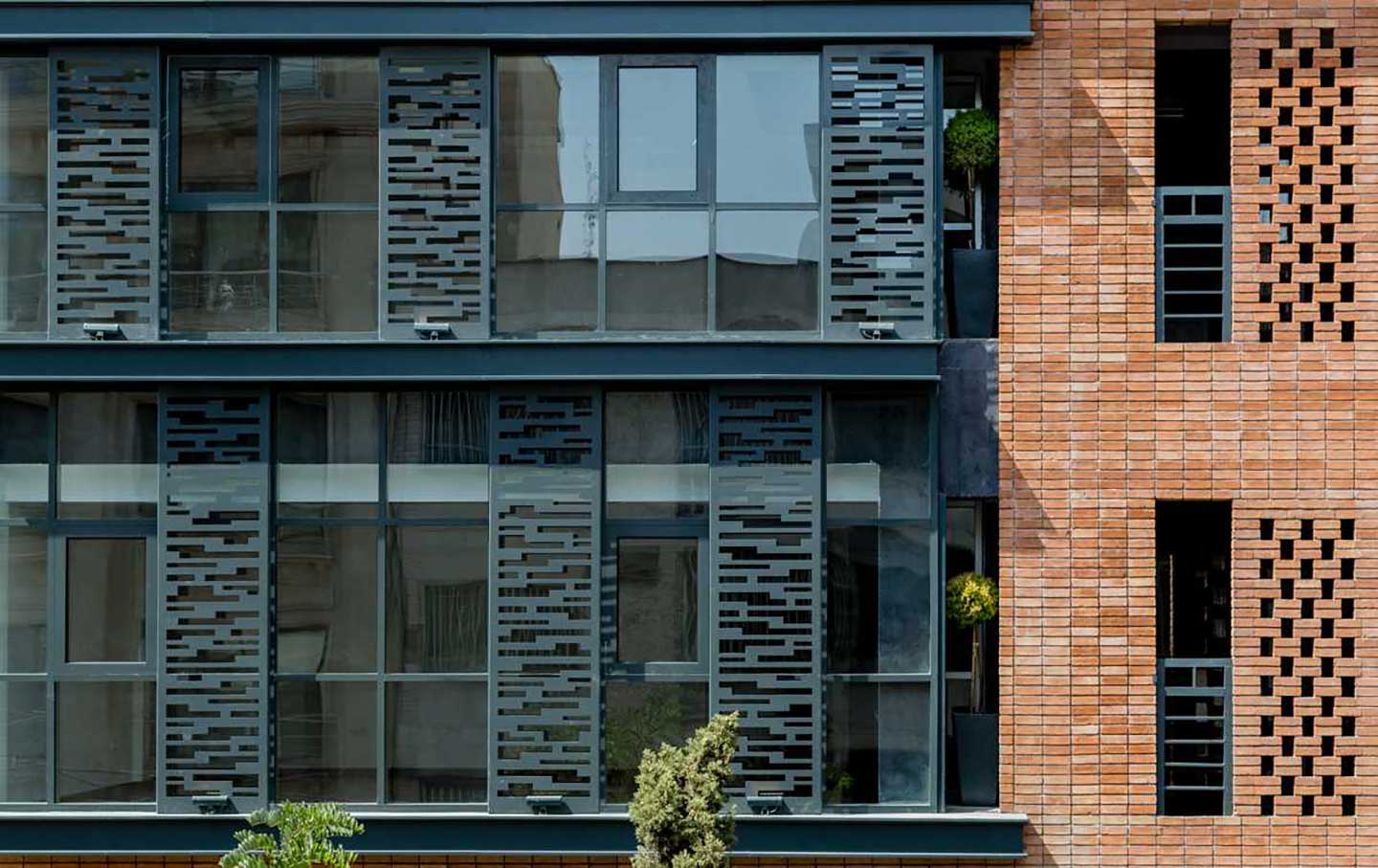World / July 23, 2025
Why the beauty and inventiveness of contemporary masonry in Iran has captured Western audiences.

The United States expends untold amounts of money and human capital to keep its citizens uninformed about the cities, people, and buildings it bombs in the Middle East. We’re all familiar with racist portrayals of Middle Easterners (itself a very muddled category) as backward, underdeveloped, and violent. Ditto their environs: When I was a child, news footage of the War on Terror was omnipresent, but all I ever saw of Baghdad or Kabul were bombed-out buildings covered in sand and detritus, plus some tents or other makeshift shelters. This kind of footage serves an obvious ideological function. You’re going to be a lot less reticent about your country bombing the open desert than you would be about shelling people sitting on terraces chatting over lunch, or families milling about markets, movie theaters, ornately decorated mosques, department stores, or schools.
We live in a different age of media now than we did then. Now we are positively image-saturated, and it is easier to secure a wide audience with less gatekeeping. Part of the reason young people have swung so heavily in favor of Palestine is because the images of human suffering inflicted by Israel are readily available on platforms such as Instagram or TikTok. (Though it’s also easier for ideologues on either side of this—or any other—issue to platform themselves than ever before.) After Israel launched its attacks on Iran in mid-June, a wave of videos and images swept social channels showing just how similar the capital of Tehran was to any other major city: Young women in trendy clothes walked into brightly lit malls, people read books in cafés, imposing buildings dotted the skyline. It was clear that nobody wanted war to begin with (at the time, 56 percent of Americans were against the idea), but also that nobody had the appetite to bomb a place so full of life. What was especially interesting about this particular media blitz was the role contemporary architecture played in communicating the cultural richness of Iran, a country Americans have been told to fear since the dawn of neoconservatism.
Every so often, the architecture world has, for lack of a better word, its memes. Several years back, there was a vogue for Brutalism, followed by its cousin, Brutalism With Trees. It was trendy to circulate images of monumental concrete structures (and then monumental concrete structures punctuated by greenery). These images would get picked up by algorithms and go viral not just once but many times. The latest trend cycle has, for perhaps the first time, had a positive effect not only on architecture but perhaps even the world.
Images of contemporary Iranian brick architecture started circulating on the Internet around the turn of the decade and flourished among those in the know. One of the earliest promoters of Iranian masonry was an account called YIMBY Tehran, which posted beautiful apartment buildings going up around the city. Philip Oldfield, an architect and the director of the University of New South Wales Built Environment program, frequently highlights Iranian architecture on his popular account @SustainableTall. These images were picked up by the rest of the architecture coterie (including yours truly) for good reason. The architecture itself is wonderful.
Iran has now become internationally renowned for its use of brickwork in sustainable buildings adapted to life in an arid climate. A simple Google search for “Iranian brickwork” rewards you with pages upon pages of master masonry in all sorts of complex patterns, forming interlocking shapes, undulations, canopies, and brise soleils (a feature that reduces glare from the sun). The latter is especially interesting, because it not only regulates light and temperature within the structure but revives a feature of traditional Persian houses, which are not exposed to the street but instead accessed through a garden or terrace.
Firms such as Admun Studios (whose 2015 Cloaked in Bricks project, featuring a brick brise soleil seemingly draped like billowing fabric over the front façade, regularly goes viral), CAAT Studio, and fundamental approach architects may not be household names, but images of their work circulate widely in the West. This work is often experimental: The brick is not only decorative, but used such that it looks lighter than it is, while playing dramatically with light and shadow. It merges structure with skin and is often combined with glass in ways that seem to test the laws of physics. This is achieved by casting new brick shapes, using new interlocking systems, and employing a bit of optical illusion. Cloaked in Bricks, for example, is such a successful project because it is not only eye-catching but sustainable. It’s not a new build but an adaptation of an existing, lackluster building.
Brickwork has long played an important role in Persian architecture simply because it is the most widely available material, tied intimately with the climate and geological features of the area. Vernacular architecture responds to its surroundings, and Persian architecture is no different. Brick resists the elements, keeps buildings cool, is amenable to building tall, and is well-suited to decorative articulation. Many of the tessellating patterns and geometric forms of Iran’s contemporary architectural language have roots in Persian architecture dating back to the Seljuk period (around the 11th through 13th centuries). According to Mahsa Kharazmi at the Museum of Islamic Art in Berlin, what separates Iranian brickwork from Western masonry is its use of complex geometrical forms, rather than the typical grid. Back in the 1980s and ’90s, critical regionalism, an idea popularized by architecture critic Kenneth Frampton, expressed a desire to counter the “placelessness” that plagued many utilitarian modernist structures by encouraging styles and techniques rooted in local cultural contexts. It’s a Western term, but aptly describes how contemporary Iranian brick architecture reconciles contemporary and historical modes, all drawing from a vernacular sense of space, behavior, and climate.
What makes this architecture so appealing to Western eyes, aside from its beauty, is its uniqueness. Architectural culture, especially in the United States, remains (with some exceptions) bound to either bloated, athletic forms and spectacle or the same dull residential minimalism it’s been shilling since the early 2000s. Practice in the field is fragmented, and there is no longer a cohesive creative or ideological movement to shape it in progressive or public-facing ways. Capital, meanwhile, pushes architectural labor to the brink and incentivizes cheapness and repetition, resulting in eyesore offices, identikit apartment buildings, and disposable single-family homes. This is merely one example of the disintegration of artistic culture writ large across all fields, as each of them enter their own crises of funding and structural decline.
More interesting architecture is happening in places where there are still strong cultural ties or attempts to use the built environment to improve the world (such as new social housing initiatives in Spain). When architecture is viewed as cultural and human enrichment rather than a playground for the rich, the results speak for themselves. The brickwork of Iran gained such traction from a primarily online audience with no ties to the country because it reminded us that better, more beautiful buildings are being built elsewhere. Architecture is an ambassador to the world; in this moment, and in the face of escalating, illegal wars, Iranian architects have done their job.
Kate Wagner
Kate Wagner is The Nation’s architecture critic and a journalist based in Chicago and Ljubljana, Slovenia.

